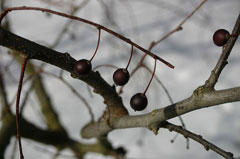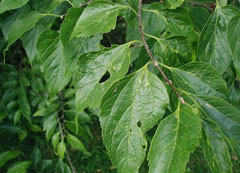 |
|
http://commons.wikimedia.org/wiki/User:Sten |
 |
| http://commons.wikimedia.org/wiki/User:Sten |
Translate this page:
Summary
Bloom Color: Green.
Main Bloom Time: Early spring, Late spring, Mid spring. Form: Rounded, Vase.
Physical Characteristics

 Celtis occidentalis is a deciduous Tree growing to 20 m (65ft) by 20 m (65ft) at a fast rate.
Celtis occidentalis is a deciduous Tree growing to 20 m (65ft) by 20 m (65ft) at a fast rate.
See above for USDA hardiness. It is hardy to UK zone 2. It is in flower in May, and the seeds ripen in October. The species is hermaphrodite (has both male and female organs) and is pollinated by Bees.
Suitable for: light (sandy) and medium (loamy) soils, prefers well-drained soil and can grow in nutritionally poor soil. Suitable pH: mildly acid, neutral and basic (mildly alkaline) soils. It cannot grow in the shade. It prefers dry or moist soil and can tolerate drought. The plant can tolerates strong winds but not maritime exposure.
UK Hardiness Map
US Hardiness Map
Synonyms
Plant Habitats
Woodland Garden Canopy;
Edible Uses
Edible Parts: Fruit Seed
Edible Uses:
Fruit - raw[2, 3, 55, 149]. Very sweet and pleasant tasting, they can be eaten out of hand or can be used for making jellies, preserves etc[183]. The fruit is often produced abundantly in Britain, it is about the size of a blackcurrant, but there is very little flesh surrounding a large seed and it is therefore a very fiddly crop[K]. The fruit is dark orange to purple- or blue-black when fully ripe, usually about 7-11mm in diameter, though occasionally up to 20mm[270]. The flesh is dry and mealy but with a pleasant sweet taste[K]. Seed[57]. No more details. The fruit and seed can be ground up finely together and used as a flavouring[161, 183]. The N. American Indians ate them with parched corn[183].
References More on Edible Uses
Medicinal Uses
Plants For A Future can not take any responsibility for any adverse effects from the use of plants. Always seek advice from a professional before using a plant medicinally.
Miscellany VD
An extract obtained from the wood has been used in the treatment of jaundice[226]. A decoction of the bark has been used in the treatment of sore throats[257]. When combined with powdered shells it has been used to treat VD[257].
References More on Medicinal Uses
The Bookshop: Edible Plant Books
Our Latest books on Perennial Plants For Food Forests and Permaculture Gardens in paperback or digital formats.

Edible Tropical Plants
Food Forest Plants for Hotter Conditions: 250+ Plants For Tropical Food Forests & Permaculture Gardens.
More

Edible Temperate Plants
Plants for Your Food Forest: 500 Plants for Temperate Food Forests & Permaculture Gardens.
More

More Books
PFAF have eight books available in paperback and digital formats. Browse the shop for more information.
Shop Now
Other Uses
Dye Fuel Miscellany Shelterbelt Wood
A dye is obtained from the roots[61]. No more details are given. Fairly wind-tolerant, it can be planted as part of a shelterbelt[200]. Wood - rather soft, weak, coarse-grained, heavy. It weighs 45lb per cubic foot and is sometimes used commercially for cheap furniture, veneer, fencing fuel etc[46, 61, 82, 171, 227].
Special Uses
Food Forest
References More on Other Uses
Cultivation details
Landscape Uses:Firewood, Aggressive surface roots possible, Street tree, Woodland garden. Succeeds in any reasonably good soil, preferring a good fertile well-drained loamy soil[1, 11, 200]. Succeeds on dry gravels and on sandy soils[200]. Tolerates alkaline soils[160]. Established plants are very drought resistant[149, 160, 200]. Wind resistant[160]. Trees transplant easily[226]. Trees prefer hotter summers and more sunlight than are normally experienced in Britain, they often do not fully ripen their wood when growing in this country and they are then very subject to die-back in winter[1, 11, 200]. Plants in the wild are very variable in size, ranging from small shrubs to large trees[43]. They are fast-growing[98, 229], and can be very long-lived, perhaps to 1000 years[200]. Only to 200 years according to another report[229]. They usually produce good crops of fruit annually[229]. Trees respond well to coppicing, readily sending up suckers after cutting or the top being killed off in a fire[226]. Plants in this genus are notably resistant to honey fungus[200]. Special Features:
North American native, Naturalizing, Wetlands plant, Attracts butterflies, Inconspicuous flowers or blooms. The plant is heat tolerant in zones 9 through 1. (Plant Hardiness Zones show how well plants withstand cold winter temperatures.
Plant Heat Zones show when plants would start suffering from the heat.
The Plant Heat Zone map is based on the number of "heat days" experienced in a given area where the temperature climbs to over 86 degrees F (30°C).
At this temperature, many plants begin to suffer physiological damage. Heat Zones range from 1 (no heat days) to 12 (210 or more heat days).
For example Heat Zone. 11-1 indicates that the plant is heat tolerant in zones 11 through 1.) For polyculture design as well as the above-ground architecture (form - tree, shrub etc. and size shown above) information on the habit and root pattern is also useful and given here if available. The plant growth habit is a standard with a non-suckering single trunk [1-2]. The root pattern is a heart root, dividing from the crown into several primary roots going down and out [1-2].
References Carbon Farming Information and Carbon Sequestration Information
Temperature Converter
Type a value in the Celsius field to convert the value to Fahrenheit:
Fahrenheit:
The PFAF Bookshop
Plants For A Future have a number of books available in paperback and digital form. Book titles include Edible Plants, Edible Perennials, Edible Trees,Edible Shrubs, Woodland Gardening, and Temperate Food Forest Plants. Our new book is Food Forest Plants For Hotter Conditions (Tropical and Sub-Tropical).
Shop Now
Plant Propagation
Seed - best sown as soon as it is ripe in a cold frame[200]. Stored seed is best given 2 - 3 months cold stratification and then sown February/March in a greenhouse[78, 200]. Germination rates are usually good, though the stored seed might take 12 months or more to germinate. The seed can be stored for up to 5 years[113]. As soon as they are large enough to handle, prick the seedlings out into individual pots. The leaves of seedlings often have a lot of white patches without chlorophyll, this is normal and older plants produce normal green leaves. Grow the seedlings on in a cold frame for their first winter, and plant them out in the following late spring or early summer[K]. Give them some protection from the cold for their first winter outdoors. Cuttings
Other Names
If available other names are mentioned here
Native Range
NORTHERN AMERICA: Canada, Québec, Ontario, Manitoba, United States, Connecticut, Indiana, Maine, Massachusetts, Michigan, New Hampshire, New Jersey, New York, Ohio, Pennsylvania, Rhode Island, Vermont, West Virginia, Illinois, Iowa, Kansas, Minnesota, Missouri, Nebraska, North Dakota, Oklahoma, South Dakota, Wisconsin, Colorado, Wyoming, Alabama, Arkansas, Delaware, Georgia (north), Kentucky, Maryland, Mississippi, North Carolina, Tennessee, Virginia, District of Columbia, Texas,
Weed Potential
Right plant wrong place. We are currently updating this section.
Please note that a plant may be invasive in one area but may not in your area so it's worth checking.
Conservation Status
IUCN Red List of Threatened Plants Status :

Growth: S = slow M = medium F = fast. Soil: L = light (sandy) M = medium H = heavy (clay). pH: A = acid N = neutral B = basic (alkaline). Shade: F = full shade S = semi-shade N = no shade. Moisture: D = dry M = Moist We = wet Wa = water.
Now available:
Food Forest Plants for Mediterranean Conditions
350+ Perennial Plants For Mediterranean and Drier Food Forests and Permaculture Gardens.
[Paperback and eBook]
This is the third in Plants For A Future's series of plant guides for food forests tailored to
specific climate zones. Following volumes on temperate and tropical ecosystems, this book focuses
on species suited to Mediterranean conditions—regions with hot, dry summers and cool, wet winters,
often facing the added challenge of climate change.
Read More
Expert comment
Author
L.
Botanical References
11200270
Links / References
For a list of references used on this page please go here
Readers comment
| Add a comment |
|
If you have important information about this plant that may help other users please add a comment or link below. Only comments or links that are felt to be directly relevant to a plant will be included. If you think a comment/link or information contained on this page is inaccurate or misleading we would welcome your feedback at [email protected]. If you have questions about a plant please use the Forum on this website as we do not have the resources to answer questions ourselves.
* Please note: the comments by website users are not necessarily those held by PFAF and may give misleading or inaccurate information.
To leave a comment please Register or login here All comments need to be approved so will not appear immediately.
|
Subject : Celtis occidentalis
|
|
|
|